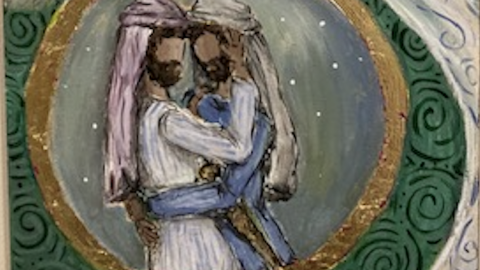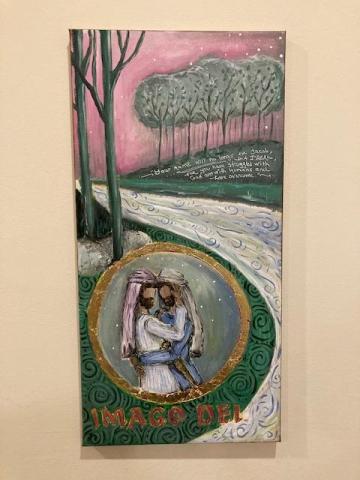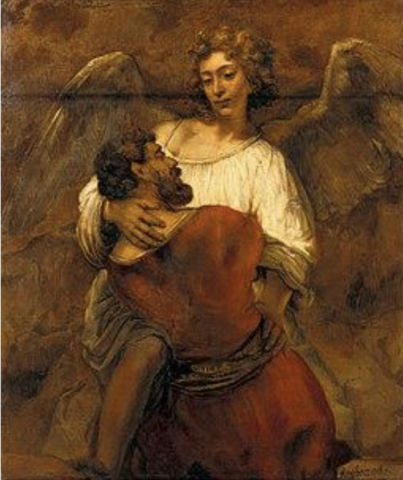Recognizing the Image of God in Every Body, Part I: Jacob Wrestles with God
April 15, 2024
0 comments
139 views

This is one of four stories of disability within the Bible that have historically been portrayed in a way that diminishes the disability story and the value of seeing God’s image within that person. However, a careful evaluation shows the story is less about offering a cure to a disabled person and more about healing relationships and restoring a sense of community and well-being. Let’s reimagine a new way of visualizing these stories through art.
To access the main article exploring Imago Dei (“image of God”) that presents an in-depth look at how we have perpetuated negative stereotypes through Biblical narrative, please look here: Recognizing the Image of God in Every Body. The rest of the series is accessible in the following posts: Story 2, Story 3, Story 4.
Many people who grew up in the church with Sunday school stories will easily remember the story of Jacob and Esau; it makes for an excellent conversation on sibling rivalry when you are a little kid.
Jacob is a conniving youth who first tricks his brother out of his birthright by trading him a bowl of stew for it when his brother is famished and will do basically anything for food. Then, as his father is dying, Jacob tricks him into believing he is Esau and receives his brother’s blessing. Constantly working an angle to get what he wants in life, he deeply hurts people. Esau, full of anger after losing everything that was rightfully his as the firstborn, declares he will kill Jacob. Jacob runs for his life! He runs all the way to his uncle, Leban, who in turn is deceitful to Jacob but also offers him a safe haven for many years.
After years of being separated from his brother, Jacob decides to return to his homeland and his brother at the prompting of God. At the start of this chapter, we see Jacob calling out to God, praying to him—one of the first prayers to God recorded for some time from Jacob. He asks God to protect him from his brother as he attempts to return to his homeland. He is so worried that his brother will want revenge on him that he divides his household into two groups, hoping that at least half will survive if his brother attacks him. Having been told that his brother is coming to confront him with an army of 400, Jacob is terrified and turns to God in his time of fear.
After sending his servants ahead with many gifts for his brother and crossing his family to safety, Jacob is left alone at the camp. It is during this time that God meets him in the most unusual way: in a wrestling match! All night, a man wrestles with Jacob. Neither relent. As writer and disability advocate Amy Kenny notes: “This is what God’s deliverance looks like: wrestling, all night long, to transform Jacob into Israel.” We are watching a metaphor play out in the darkness.
Jacob has always been tenacious, working angles to get ahead in life, relying on his own strength, fortitude, and brains to succeed. Yet, this night of wrestling with God demonstrates something profound: we need to let go, giving space for God to show up and lead us rather than trying to manage life alone. Yes, by all accounts, Jacob had done well in the world, but he was separated from his family and from God. He needed to stop fighting and give God space to lead.
What we see next is profound: God disables Jacob, leaving him with a limp that he will live with for the rest of his life. But in this, we see healing, with God restoring Jacob to him. Amy Kenny describes it this way: “His limp becomes a beautiful reminder of this transformative encounter. Instead of curing Jacob or killing him off, Scripture introduces a disability that tethers him to the graciousness of the living God.” In other words, Jacob learns dependence on God. He no longer needs to fight for his worth; he is simply worthy of God’s love. His limp is a constant reminder of God with him.
As he takes his family to meet Esau and his army of 400, we watch a beautiful story of reconciliation play out in Genesis 33. The Jacob we knew has been transformed into a gentle, loving, giving brother. He enters his brother’s land with humility and generosity. We see a man transformed after wrestling with God.
We are given a final beautiful image of Jacob in Hebrews 11:21 (NLV): “It was by faith that Jacob, when he was old and dying, blessed each of Joseph’s sons and bowed in worship as he leaned on his staff.”
Perspective from Disabled Scholar, Amy Kenny (PhD)
There’s a lot that limping has taught me over the years. Using my cane and wheelchair has given me a different perception on who I am and who God is. There’s a freedom in using mobility devices that’s tricky for nondisabled people to understand. There’s a freedom in using mobility devices that acknowledges the limits of my body and declares that I can’t do it all by myself, and that's not something to be ashamed of.
In fact, for an Enneagram 1 and recovering know-it-all, that’s liberating for me. None of us do it alone. All of us are dependent on one another for survival. Those of us who are disabled already know how to welcome interdependence as a habitual practice without demonizing our bodies in the process…We don’t rely on our bodies to praise God, but have a deeper sense of who God is because of our acknowledged interdependence (Kenny, pp 83-85).
Re-envisioning the story
Who wouldn’t want to capture the epic moment in the scriptures where Jacob is wrestling with God? This is the stuff movies are made of. When you think of it, the whole story could be made into a blockbuster hit: the trickster robbing his brother, deceiving his father, running to his uncle, and marrying both the uncle’s daughters. This is prime-time drama!
He ends up being super rich and having a huge family and tons of property, but he knows he is missing something very important: his brother’s love and respect.
The movie pans to Jacob traveling across the country, bringing all his material wealth, his two gorgeous wives, and their eleven kids; it doesn’t get better than this!
But wait—he sends them on ahead, and then we come to the climax of the movie, God hurtling down from heaven to have a big wrestling match with Jacob. This is epic! It is no wonder so many artists have taken paintbrush to canvas over the years and depicted this pivotal moment in the life of Jacob.
However, is this the moment we want to focus on? Yes, the fight is a metaphor for how hard it will be for Jacob to turn from his ways and let love lead him back home. But should this be the point in the story we choose to highlight? While there is power in this moment, where is the moment of love and reconciliation?
To re-envision the story, I propose that we focus on the point in the story when Jacob is brought into reunion with his brother. Up to this point, when the brothers were together, they were in conflict. Although twins, they were very different personalities and did not understand each other, nor did they care to. Jacob made choices that devastated their relationship.
What would it be like for Jacob to return to his brother? He would have been dealing with significant guilt and fear as he sought reconciliation. However, his time wrestling with God and becoming physically disabled in the sight of God had given space for the transformation of his spirit.
He was no longer Jacob but was now Israel, as God had blessed him with a new name. As verse 28 tells us, “Your name will no longer be Jacob, but Israel, because you have struggled with God and with men and have overcome.”
Re-envisioning involves an understanding of holistic healing; in this case, we see a very unusual version of healing. Jacob was not cured from a physical disability but rather given one! Yet, it was in wrestling, in the receiving of the disability, that he received holistic healing. His heart was softened, and he saw the face of God. Morning comes, and Jacob is now Israel, a man ready to return home.
Therefore, let’s shift the focus of this story to the reunion of the brothers. We see Jacob/Israel humble himself before his brother, and his brother, in return, so thankful to see him, bringing him back into the circle of love he had wandered away from for so long. This is the moment of holistic healing.


Disability Concerns, Church Admin & Finance
Disability Concerns, Church Admin & Finance
Disability Concerns, Training and Education
Disability Concerns
Connect to The Network and add your own question, blog, resource, or job.
Add Your Post
Let's Discuss
We love your comments! Thank you for helping us uphold the Community Guidelines to make this an encouraging and respectful community for everyone.